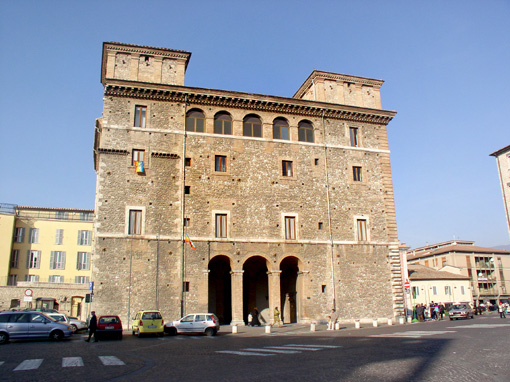Palazzo Spada (Terni) on:
[Wikipedia]
[Google]
[Amazon]
 Palazzo Spada is a palace in
Palazzo Spada is a palace in
Key to Umbria: Terni — Palazzo Spada (1555-75)
{{Coord, 42.560574, N, 12.647091, E, display=title Houses completed in the 16th century Palaces in Umbria Terni
 Palazzo Spada is a palace in
Palazzo Spada is a palace in Terni
Terni ( ; ; ) is a city in the southern portion of the region of Umbria, in Central Italy. It is near the border with Lazio. The city is the capital of the province of Terni, located in the plain of the Nera (Tiber), River Nera. It is northeast ...
, Umbria
Umbria ( ; ) is a Regions of Italy, region of central Italy. It includes Lake Trasimeno and Cascata delle Marmore, Marmore Falls, and is crossed by the Tiber. It is the only landlocked region on the Italian Peninsula, Apennine Peninsula. The re ...
, central Italy
Italy, officially the Italian Republic, is a country in Southern Europe, Southern and Western Europe, Western Europe. It consists of Italian Peninsula, a peninsula that extends into the Mediterranean Sea, with the Alps on its northern land b ...
, built on behest of Count Michelangelo Spada in the mid-16th century and designed by Antonio da Sangallo the Younger
Antonio da Sangallo the Younger (12 April 14843 August 1546), also known as Antonio Cordiani, was an Italian architect active during the Renaissance, mainly in Rome and the Papal States. One of his most popular projects that he worked on des ...
. It currently serves as the town hall for the city. Alexandre de Rogissart wrote about the palace in the eighteenth century, remarking the beauty of its structure.
The inner lounges are decorated with cinquecento
The cultural and artistic events of Italy during the period 1500 to 1599 are collectively referred to as the Cinquecento (, ), from the Italian for the number 500, in turn from , which is Italian for the year 1500. Cinquecento encompasses the st ...
frescoes, which were supplemented with newer decorations in the 18th century. The palace passed to the Massarucci family in the 19th century and subsequently was given to the Sisters of the Infant Jesus
The Sisters of the Infant Jesus, also known as the Dames of Saint Maur, are a religious institute of the Catholic Church originating from Paris, France and dedicated to teaching.
History
Origins
In 1659 Barré, who was a respected scholar with ...
. After being handed over to the municipal administration of Terni, it was restored to render it fit for its new role as the city's town hall.
The main floor rooms are decorated with frescoes dating from the second half of the sixteenth to the nineteenth centuries. Central to the ceiling of the main hall, which is currently used as the seat of the city council, is a representation of Phaëton punished by Jupiter; at the sides are depicted, in six panels, scenes from the Battle of Lepanto
The Battle of Lepanto was a naval warfare, naval engagement that took place on 7 October 1571 when a fleet of the Holy League (1571), Holy League, a coalition of Catholic states arranged by Pope Pius V, inflicted a major defeat on the fleet of t ...
and the Massacre of the Huguenots. The frescoes in the main lounge, which are painted in a late-Mannerist
Mannerism is a style in European art that emerged in the later years of the Italian High Renaissance around 1520, spreading by about 1530 and lasting until about the end of the 16th century in Italy, when the Baroque style largely replaced it ...
style, are traditionally attributed to Karel van Mander
Karel van Mander (I) or Carel van Mander IKarel van Mander
at the Netherlands Institute for Art History ...
.
Beneath the vault are landscapes, alternating with coats of arms of popes and bishops, prominent among them the one of Pope Julius III, who made Michelangelo Spada a count.
at the Netherlands Institute for Art History ...
References
External links
Key to Umbria: Terni — Palazzo Spada (1555-75)
{{Coord, 42.560574, N, 12.647091, E, display=title Houses completed in the 16th century Palaces in Umbria Terni